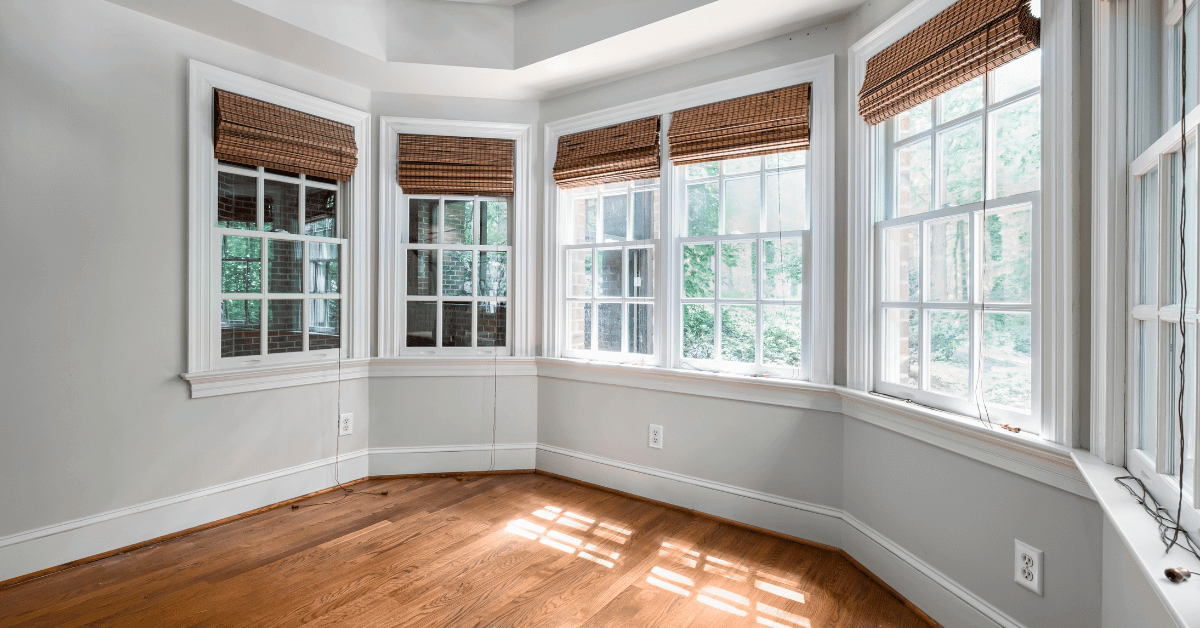The cost of new windows is a crucial consideration for homeowners in 2024 aiming to boost their property’s energy efficiency, aesthetic appeal, and overall market value through replacing their windows. Endorsed by the U.S. Environmental Protection Agency, energy-efficient windows can play a significant role in this enhancement. This significant renovation project’s expenses are shaped by a variety of factors, such as materials, design, and labor costs. This comprehensive guide is designed to lead you through the pricing, advantages, and key factors necessary to make an informed choice.
As of 2024, the typical expense for window replacement in a home ranges from $614 to $1,309 for each window. This price encompasses the following components:
- The cost of the window itself, influenced by the type of window, frame, and glass chosen. Prices for the window materials alone are anticipated to fall between $383 and $815.
- The fees associated with labor and professional installation. Depending on the complexity of the window replacement project, installation charges are expected to average between $70 and $150 per window.
Disclaimer: Please note that these figures are estimates and can vary based on multiple factors including material choices, home size, and installation complexities. To determine the precise cost for your specific situation, obtaining a personalized quote from a professional service provider is highly recommended. Cost figures in this article are based on 2024 reports for The Home Depot, HomeGuide, and Modernize.
Best Windows Replacement Companies
| Company | Logo | Star rating | Website |
|---|---|---|---|
| Nationwide Windows |  | 4.9 ⭐⭐⭐⭐⭐ | Visit website |
| Modernize |  | 4.6 ⭐⭐⭐⭐⭐ | Visit website |
| MyHomeQuote |  | 4.5 ⭐⭐⭐⭐⭐ | Visit website |
| Renewal by Andersen |  | 4.4 ⭐⭐⭐⭐ | Visit website |
| Champion |  | 4.4 ⭐⭐⭐⭐ | Visit website |
Understanding the Cost of New Windows
The cost of new windows in 2024 is influenced by several key factors, from the window type and material to customization and installation complexities. Homeowners can expect a range of prices, significantly affected by their choice between standard and custom window solutions. Whether it’s a basement window replacement cost or the cost to repair window frames, understanding these factors can help you budget effectively for your project.
Factors Influencing Window Replacement Cost
Type of Windows
The average price of window replacement varies significantly with the type of window you choose. For instance, single-hung windows might be on the lower end of the price spectrum, while bay or bow windows can be substantially more due to their size, complexity, and the dramatic aesthetic they add to a room.
- Single-Hung Windows: $397 – $847
- Double-Hung Windows: $429 – $915
- Casement Windows: $597 – $1,273
- Bay and Bow Windows: $1,732 – $3,859
These variations reflect the diversity in residential window replacement options available, catering to different aesthetic preferences and functional needs.
You can also read our guide on single-hung vs double-hung windows.
Material Costs
The choice of material directly impacts the window and frame replacement cost. Vinyl windows, known for their affordability and energy efficiency, might cost between $150 to $850 per window. In contrast, wood frames, which offer unparalleled natural beauty and insulation, can range from $250 to $1865, reflecting their higher quality and maintenance requirements.
Labor Costs
Labor costs for installing windows can vary by region and complexity of the job. Standard installations might range from $100 to $300 per window, but more complex projects like basement window replacement or full-frame installations could significantly increase these costs.
Energy efficiency
Are you considering investing in energy-efficient windows like double-pane, triple-pane, thermal, or those with ENERGY STAR certification? While these options may have a higher initial cost, they can lead to savings on your energy bills after installation, ultimately resulting in long-term financial benefits.
Window size & type of glass
The size and glass type are pivotal factors that influence cost. A compact window for a bathroom will cost you less compared to the installation of a larger window designed for a living room setting. Moreover, glass, a significant part of your material costs, offers various options such as insulated, tempered, and privacy glass, or a mix of these choices, each impacting the overall investment in your window replacement or installation project
Types of Costs
Let’s explore three distinct cost scenarios to give you a clearer idea of the potential expenses for window replacement across low, mid, and high price brackets. Begin by reviewing the table below for an overview of the average cost ranges, followed by a detailed explanation of what’s included in each price category.
| Project Price Brackets | Average Prices |
|---|---|
| Low-Range | $150 – $400 |
| Mid-Range | $400 – $700 |
| High-Range | $700 – $1,200+ |
Low-Range Window Replacement Option
- Price Range: Affordable window replacement typically falls between $150 and $400 per window.
- Type of Window: In this price bracket, you’ll mostly find basic single or double-hung windows.
- Frame Material: Vinyl stands out as the most budget-friendly option, offering durability, low maintenance, and satisfactory insulation.
- Glass Options: Standard offerings in this category often include single-pane glass, though some options might feature double-pane glass sans advanced features like argon gas fills or low-E coatings.
- Installation Details: The installation process is straightforward for standard-sized windows requiring little to no structural changes. Costs remain on the lower end when the existing frames are still in good shape and can accommodate the new windows.
Mid-Range Window Replacement Options
- Price Range: Typically, mid-range window replacement costs vary from $400 to $700 per window.
- Type of Window: This price bracket offers a wider selection of styles, such as casement and sliding windows, and may include options for custom sizes.
- Frame Material: Options often include superior-quality vinyl or basic wooden frames, with fiberglass frames also a possibility within this budget.
- Glass Options: Standard features include double-pane glass equipped with energy-saving enhancements like low-E coatings and argon gas fill, enhancing insulation and overall energy efficiency.
- Installation Details: Installation may necessitate slight customizations to accommodate the window openings or minor structural adjustments to the property, making the process slightly more complex than that of more budget-friendly alternatives.
High-Range Window Replacement Options
- Price Range: High-end window replacement projects typically start from $700 to $1,200, extending upwards for more elaborate options.
- Type of Window: This category includes intricate styles such as bay or bow windows, with custom dimensions and shapes being a standard offering.
- Frame Material: In this premium segment, choices extend to top-tier wood, fiberglass, or composite frames, all recognized for their superior aesthetics, longevity, and thermal efficiency.
- Glass Options: Features triple-pane glass equipped with cutting-edge energy-saving technologies, including UV protective coatings, inert gas insulation, and thermal barriers, ensuring optimal thermal performance and sound dampening.
- Installation Details: Customization levels and potential structural modifications are more extensive, requiring skilled craftsmanship and potentially lengthening the installation timeframe, reflecting in the higher investment.
How Much Is a Window? Price Breakdown by Window Type
When homeowners ask, “How much should I expect to pay for a new window?” they must consider both the window type and the installation costs. For example, the cost to repair window frames or sills must also be factored into the overall budget if existing structures are damaged or outdated.
| Type of Window | Avg Cost Per One Window |
|---|---|
| Egress Windows | $160 to $750 |
| Storm Windows | $172 to $320 |
| Jalousie Windows | $175 to $375 |
| Hopper Windows | $170 to $645 |
| Transform Windows | $334 to $711 |
| Arched Windows | $345 to $950 |
| Single-Hung Windows | $397 to $847 |
| Double-Hung Windows | $429 to $915 |
| Glass Block Windows | $450 to $1,100 |
| Circle Windows | $450 to $1,200 |
| Awning Windows | $477 to $1,107 |
| Casement Windows | $597 to $1,273 |
| Picture Windows | $609 to $1,298 |
| Sliding Windows | $775 to $1,652 |
| Skylight Windows | $900 to $2,500 |
| Sliding Glass Door Windows | $1,070 to $2,690 |
| Garden Windows | $1,350 to $1,800 |
| Bay Windows | $1,732 to $3,690 |
| Bow Windows | $1,810 to $3,859 |
Window Price Breakdown By Glass Type
Selecting the right window glass type can enhance your home’s energy efficiency, leading to lower utility expenses. Energy-efficient window glass minimizes heat transfer, helping maintain your home’s temperature—cooler in summer and warmer in winter. Beyond energy conservation, various window glass types also offer benefits like noise reduction, impact resistance, and increased privacy.
Window glass replacement costs vary, typically ranging between $280 and $325. Below is a breakdown of the average replacement costs for different window glass types as of 2024.
| Type of Glass | Average Replacement Cost |
|---|---|
| Single Pane Glass | $100 to $400 |
| Tempered Glass | $175 to $600 |
| Laminated Glass | $275 to $600 |
| Frosted Glass | $300 to $700 |
| Low E Glass | $350 to $850 |
| Triple Pane Glass | $400 to $700 |
| Gas-Filled Glass | $375 to $1,000 |
| Double Pane Glass | $613 to $1,307 |
Window Price Breakdown By Frame Type
In the process of window replacement, homeowners can select from a variety of frame materials such as vinyl, wood, fiberglass, and aluminum, each varying in cost, durability, and quality.
For instance, vinyl windows are an economical choice at approximately $400 per window, while clad wood composite windows offer enhanced durability but carry a heftier price, potentially as much as $1,800 per window.
Below, you’ll find an overview of the average pricing and advantages of each window frame material. These estimates are based on the standard-sized double-hung window, which is widely considered the most prevalent window type in American homes. Expect prices to increase for more high-end window designs.
| Type of Frame | Average Cost Per Window |
|---|---|
| Fiberglass Windows | $320 to $683 |
| Vinyl Windows | $391 to $834 |
| Aluminum Windows | $397 to $846 |
| Wood Windows | $875 to $1,865 |
| Composite Windows | $950 to $1,800 |
Choosing the Best Windows for Your Home
When selecting windows, think beyond just the price. Consider how the window design complements your home’s architectural style. For instance, traditional homes may benefit from the classic look of wood or composite frames, while modern homes might look best with sleek, minimal aluminum or vinyl frames. Energy considerations are also paramount; in colder climates, windows with higher insulation values (indicated by a lower U-factor) can lead to significant heating cost savings.
Let’s examine some of the most sought-after window styles that you’re likely to consider:
| Type | Illustration | Description |
|---|---|---|
| Single-Hung Window |  | This window features a single movable sash and opens vertically, making it an affordable choice suitable for ground floors and spaces requiring an exit route. |
| Double-Hung Window |  | A favorite in the U.S., this window type opens vertically with two movable sashes, one at the bottom and one at the top, offering excellent ventilation for areas like kitchens and upper floors where heat accumulates. |
| Picture Window |  | Known for its affordability and the expansive views it offers through a large, uninterrupted pane of glass, this window type does not open, providing a static view. |
| Casement Window |  | Gaining in popularity for its expansive views with fewer obstructions, casement windows open outwardly by swinging rather than sliding upwards. |
| Sliding Window |  | Perfect for long or narrow wall spaces, sliding windows open horizontally, providing significant airflow. |
| Bay Window |  | An upscale option, bay windows extend outward from the home’s facade, adding extra space indoors. They consist of three or more windows, with at least one that opens. |
| Awning Window |  | Similar in operation to casement windows but opening outward from the bottom, awning windows create a protective awning effect when open. |
Remember, most homeowners find themselves needing to replace or install multiple windows simultaneously, often ranging from 20 to 30 in a single project. To accurately assess how many windows you’ll need to install or replace, it’s advisable to consult with a professional local window contractor who can evaluate your home and provide tailored advice.
Our Recommendations For Window Installers
The market is flooded with numerous windows installation companies, making it challenging to determine the best fit for your needs. After thorough analysis and review of a wide range of windows companies, along with their offerings and services, we’ve identified our top three recommendations for installing or replacing your windows. We highly recommend that you get free quotes from at least three different companies.
Popular

- Large selection of window types
- Compare quotes from local window contractors
- Get clear-cut window quotes and comparable pricing options
Our top pick

- Quickest estimates
- Database of hundreds of professional contractors
- Affordable yet highly professional
Great choice

- Pairs you with up to four pre-vetted pros from their network.
- Free cost calculator
- 24/7 support
The team at HomeUpgradeInstalls supports our suggestions for windows installation companies with a comprehensive evaluation system, designed to impartially assess each product and its provider. Our approach includes examining product details and the information available on provider websites, engaging in conversations with customer service teams, and scrutinizing user feedback. Based on these investigations, we rate each company according to our criteria, covering aspects such as windows quality, client service, the quoting procedure, the range of services offered, and overall customer satisfaction, culminating in an overall rating out of five points.
Do I Need To Replace My Windows?
If you are not sure whether your windows need to be replaced or not, consider looking at the following factors:
- Moisture Between Panes: The presence of condensation between window panes, especially in double- or triple-glazed windows, often signals compromised seals, allowing moisture entry. Opting for windows with better energy efficiency can eliminate such moisture problems, enhancing your home’s energy management.
- Feeling Drafts and Leaks: Experiencing a chill or warmth around window edges suggests inadequate sealing. By feeling around the window’s frame and glass, you can detect if improper sealing is causing drafts, pointing towards the necessity for window replacement.
- Noise Penetration: If your residence is older with outdated windows, you might notice it doesn’t sufficiently block external sounds. Modern windows, particularly those with multiple panes, are designed to significantly reduce noise intrusion, offering a quieter, more serene living space.
- Increasing Energy Bills: Inefficient windows can lead to higher utility bills by allowing heat exchange between your home’s interior and the outdoor environment. This inefficiency forces heating and cooling systems to overcompensate. Replacing old windows with newer, energy-efficient models can curb this issue, stabilizing your energy expenses.
- Operational Difficulties: If opening or closing your windows has become a challenge, it could be due to various problems like frame warping, poor installation, or decay, all of which merit a professional evaluation to decide between repair and replacement.
- Frame Decay: Exposure to moisture can severely affect wooden window frames, leading to rot or mold issues. Such deterioration not only compromises the window’s structure but can also pose health risks, underscoring the importance of replacing compromised windows.
- Obvious Physical Damage: Any visible signs of damage — be it cracks, breaks, or warping — directly impact your window’s integrity and your home’s security. Moreover, signs of mold or rot highlight potential water damage, necessitating immediate window replacement for the safety and health of your household.
Can I Install Windows Myself?
While it’s possible to undertake the installation of replacement windows on your own, it may not be as cost-saving as one might anticipate. Opting for a DIY approach could void your warranty if issues arise later, as many manufacturers’ warranties stipulate that installation must be carried out by professionals.
Without extensive experience in home improvement and construction, correctly installing a window might be beyond your capabilities. Incorrect installation can lead to various problems, such as air leaks, water entry, damaged window components, and costly repairs that could impact your entire home. Moreover, modern window systems often require complex attachment methods that may not be manageable for the average homeowner.
Experts in window installation not only bring the right skills for accurate installation but also have a deep understanding of potential operational issues. These professionals are well-versed in local building codes and regulations, ensuring your new windows comply with all necessary standards. They are also equipped to handle common challenges, including issues with siding, and the presence of lead paint or asbestos.
Step-by-Step Guide to Window Replacement
Whether you’re considering a DIY approach or seeking to understand the procedure before hiring a professional, this quick guide will outline the essential steps, ensuring you’re well-prepared for this home improvement venture.
Step 1: Removing the Old Window
Carefully pry away the molding or trim around the old window. Protect the wall and surrounding areas as you work. Once the trim is removed, check if there are sash cords or chains that need to be detached. If the window is old, you may have to cut through paint layers or pull out old nails. Carefully lift the sash from the window frame, and if the window has multiple panels, remove them one at a time.
Step 2: Preparing the Frame
With the old window out, inspect the frame for damage such as rot, mold, or warping. Repair any damage before proceeding to ensure a solid foundation for the new window. Clean out any debris and old caulk from the frame. Check for squareness by measuring the diagonals of the frame; they should be equal. If not, you may need to use shims later to ensure the new window sits level and square.
Step 3: Installing the New Window
Dry fit the new window into the opening to make sure it fits. If all looks good, apply a bead of caulk along the inside of the outside window stops and the sill. Carefully place the new window into the frame, pressing it firmly against the caulk. Use shims to adjust for level and plumb; this is crucial for proper operation. Once in place, secure the window with screws at the pre-drilled holes, through the shims, ensuring not to over-tighten.
Step 4: Sealing and Finishing
Once the window is installed, inspect the edges for any gaps. Fill these gaps with expanding foam insulation, taking care not to overfill as this can warp the frame. After the insulation sets, replace or install new interior trim. Then, apply a bead of caulk around the outside of the window for a weather-tight seal. Finish by checking the window for proper operation and clean any excess material from the glass and frame.
Remember, while DIY window replacement can be a cost-saving venture, it requires precision and care. If you’re not comfortable with the process, it’s always best to hire a professional to ensure your windows are installed correctly.
What Are The Benefits of Replacing Your Windows?
Investing in new windows for your home is not just about improving its aesthetic appeal; it’s a strategic move that can bring a multitude of benefits, from enhancing energy efficiency to boosting your property’s market value. By replacing old, inefficient windows with modern alternatives, homeowners can enjoy improved comfort, lower utility bills, and a more attractive living space. Let’s delve deeper into the significant advantages of window replacement.
Energy Efficiency and Savings
Modern windows are designed with energy efficiency at their core, utilizing advanced technologies such as double glazing, low-E coatings, and inert gas fills to minimize heat transfer. This technological advancement ensures that your home stays warmer in the winter and cooler in the summer without overburdening your HVAC system. The result is a noticeable reduction in heating and cooling costs, providing financial savings that accumulate over time. Consequently, the initial investment in window replacement can pay for itself through these energy savings, making it a financially savvy decision for homeowners looking to optimize their home’s energy consumption.
Increased Home Value
The impact of new windows on your home’s value cannot be overstated. By updating your windows, you not only enhance the curb appeal of your property but also its overall functionality and energy efficiency. These improvements are highly valued in the real estate market, making your home more attractive to potential buyers. This is especially beneficial for homeowners contemplating selling their property, as the upgraded windows can lead to a higher selling price. Beyond the immediate aesthetic improvements, the added benefits of reduced noise pollution, enhanced security, and better UV protection contribute to making your home a more appealing and comfortable living space. This comprehensive upgrade significantly elevates the marketability of your home, offering an attractive return on investment that is hard to ignore.
Conclusion
The journey to replacing windows in 2024 offers homeowners an opportunity to enhance their home’s energy efficiency, functionality, and aesthetic appeal. By understanding the factors that affect the cost of new windows, evaluating your options carefully, and maintaining your new windows properly, you can make an investment that improves your quality of life and increases your home’s value. Remember, the best window replacement is one that fits your budget, meets your aesthetic preferences, and addresses your home’s specific needs. With the right approach, your new windows can be a source of satisfaction and comfort for many years to come.
FAQs: Everything You Need to Know About Windows Replacement
How much should I expect to pay for a new window?
The typical expense for window replacement in a home ranges from $614 to $1,309 for each window, encompassing both materials and labor.
How long does it take to replace a window?
Replacing a window can take anywhere from a few hours to a full day per window, depending on the complexity of the installation, the condition of the existing frame, and whether any structural adjustments are needed.
Is it cheaper to replace all windows at once?
Bulk replacements can offer cost savings and ensure uniform aesthetics and performance. Many window companies will offer discounts on bigger installation orders.
What is the lifespan of a house window?
High-quality windows can last 15 to 20 years, depending on the material and maintenance.
Do new windows increase home value?
Absolutely. They are a valuable upgrade that enhances both the energy efficiency and curb appeal of your home.
How do you know when a window needs to be replaced?
There are several telltale signs that it might be time for a window replacement:
- Difficulty opening or closing the window
- Noticeable drafts or cold spots near the window
- Condensation between panes of glass
- Visible damage to the frame or glass
What Is The Cheapest Window Replacement Option?
Choosing a vinyl picture window is often the most budget-friendly choice for window replacement.
The cost-effectiveness of vinyl as a frame material, combined with the fact that picture windows don’t open, contributes greatly to reducing the overall expense on materials.

